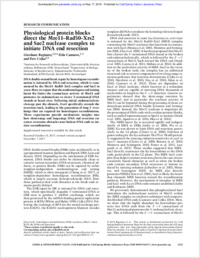Physiological protein blocks direct the Mre11–Rad50–Xrs2 and Sae2 nuclease complex to initiate DNA end resection
- Reginato, Giordano Institute for Research in Biomedicine (IRB), Faculty of Biomedical Sciences, Università della Svizzera italiana, Switzerland - Department of Biology, Institute of Biochemistry, Eidgenössische Technische Hochschule (ETH) Zurich, Switzerland
- Cannavo, Elda Institute for Research in Biomedicine (IRB), Faculty of Biomedical Sciences, Università della Svizzera italiana, Switzerland
- Cejka, Petr Institute for Research in Biomedicine (IRB), Faculty of Biomedical Sciences, Università della Svizzera italiana, Switzerland - Department of Biology, Institute of Biochemistry, Eidgenössische Technische Hochschule (ETH) Zurich, Switzerland
-
2017
Published in:
- Genes and Development. - Cold Spring Harbor Laboratory Press. - 2017, vol. 31, no. 23-24, p. 2325-2330
English
DNA double-strand break repair by homologous recombination is initiated by DNA end resection, which is commenced by the Mre11–Rad50–Xrs2 complex and Sae2 in yeast. Here we report that the nonhomologous end joining factor Ku limits the exonuclease activity of Mre11 and promotes its endonuclease to cleave 5'-terminated DNA strands at break sites. Following initial endonucleolytic cleavage past the obstacle, Exo1 specifically extends the resection track, leading to the generation of long 3' overhangs that are required for homologous recombination. These experiments provide mechanistic insights into how short-range and long-range DNA end resection enzymes overcome obstacles near broken DNA ends to initiate recombination.
- Language
-
- English
- Classification
- Biological sciences
- License
- Open access status
- hybrid
- Identifiers
-
- RERO DOC 324104
- DOI 10.1101/gad.308254.117
- ARK ark:/12658/srd1318798
- Persistent URL
- https://n2t.net/ark:/12658/srd1318798
Statistics
Document views: 169
File downloads:
- Texte intégral: 241
